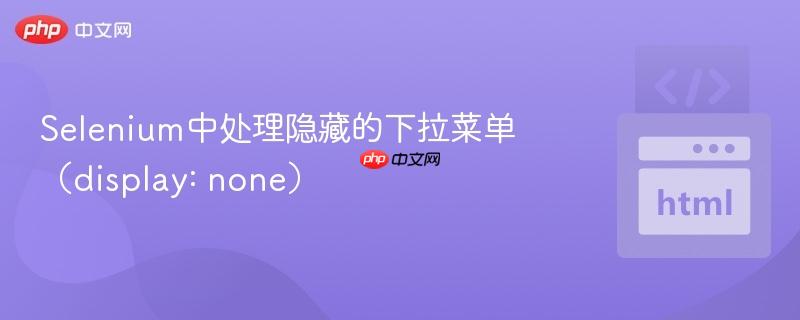
本文旨在解决Selenium自动化测试中无法与样式属性为`display: none`的下拉菜单进行交互的问题。核心解决方案是利用Selenium的`execute_script`方法,通过JavaScript动态修改元素的样式,使其变为可见状态,从而允许Selenium的`Select`类或其他交互方法对其进行操作。
在Web自动化测试中,Selenium WebDriver旨在模拟真实用户的行为。这意味着,如果一个元素在用户界面上是不可见的(例如,通过CSS属性display: none或visibility: hidden),Selenium通常也无法直接对其进行交互。这对于那些在DOM中存在但被隐藏的下拉菜单(<select>元素)尤其常见,它们可能在特定用户操作后才显示,或者被自定义的UI组件所替代。
当一个HTML元素的CSS属性设置为display: none时,它不仅在视觉上从页面中消失,而且在布局上也不占据任何空间。Selenium在尝试查找或操作这类元素时,会认为它们是不可交互的,因为真实用户无法看到或点击它们。因此,直接使用find_element后尝试click()、send_keys()或通过Select类进行选择,都会导致ElementNotInteractableException或类似的错误。
考虑以下HTML结构:
<div class="InputField_Con" tabindex="-1">
<div class="InputField_InputCon">
<input id="TextID_Search" class="InputField_Search" type="text" role="search" autocomplete="off" style="width: 205.2px;" aria-label="* Typ:">
</div>
</div>
<select class="Modern Val_Req " id="TextID" name="TextID" style="display: none;" aria-required="true">
<option value="">-</option>
<option value="1">Text1</option>
<option value="2">Text2</option>
<option value="3">Text3</option>
<option value="4">Text4</option>
<option value="5">Text5</option>
</select>在这个例子中,id="TextID"的<select>元素被明确地设置为style="display: none;"。
面对上述隐藏的下拉菜单,常见的Selenium操作方法通常会失败:
尝试通过可见输入框触发(如果存在):
from selenium import webdriver
from selenium.webdriver.common.keys import Keys
import time
# 假设 driver 已经被初始化
# driver = webdriver.Chrome()
# driver.get("your_page_url")
# 尝试向可见的输入框发送文本并模拟按键
try:
search_input = driver.find_element("id", "TextID_Search")
search_input.send_keys("Text3")
search_input.send_keys(Keys.DOWN)
search_input.send_keys(Keys.RETURN)
print("尝试通过输入框操作,可能失败。")
except Exception as e:
print(f"通过输入框操作失败: {e}")这种方法取决于页面的具体实现逻辑。如果输入框只是一个搜索字段,而实际的下拉选择逻辑仍然依赖于隐藏的<select>,那么这种模拟按键的方式可能无法正确选择隐藏的选项。
直接使用Select类操作隐藏的<select>元素:
from selenium.webdriver.support.ui import Select
from selenium.webdriver.support import expected_conditions as EC
from selenium.webdriver.common.by import By
from selenium.webdriver.support.ui import WebDriverWait
# 假设 driver 已经被初始化
# driver = webdriver.Chrome()
# driver.get("your_page_url")
try:
# 尝试等待元素可点击(但它仍然是隐藏的)
WebDriverWait(driver, 10).until(EC.element_to_be_clickable((By.ID, "TextID")))
my_select_element = driver.find_element(By.ID, 'TextID')
drop_down_menu = Select(my_select_element)
drop_down_menu.select_by_visible_text('Text3')
print("直接使用Select类操作隐藏元素,预计会失败。")
except Exception as e:
print(f"直接操作隐藏下拉菜单失败: {e}")WebDriverWait的element_to_be_clickable条件会检查元素是否可见且启用。由于TextID的display属性为none,它将永远不会被认为是可点击的,或者即使找到元素,Select类在内部也会检查元素的可见性,导致操作失败。
解决此问题的核心思路是,在Selenium尝试与元素交互之前,利用JavaScript直接修改元素的样式,使其变为可见状态。Selenium提供了execute_script()方法,允许在当前浏览器上下文中执行任意JavaScript代码。
步骤:
完整Python代码示例:
from selenium import webdriver
from selenium.webdriver.common.by import By
from selenium.webdriver.support.ui import Select
from selenium.webdriver.support.ui import WebDriverWait
from selenium.webdriver.support import expected_conditions as EC
import time
# 假设已经配置好WebDriver
# 例如,使用Chrome浏览器
driver = webdriver.Chrome() # 请确保ChromeDriver已在PATH中或指定路径
driver.get("file:///path/to/your/html/file.html") # 替换为你的HTML文件路径或实际URL
# 如果是本地HTML文件,需要先创建一个包含上述HTML内容的本地文件
# 示例HTML内容:
# <html><body>
# <div class="InputField_Con" tabindex="-1"><div class="InputField_InputCon"><input id="TextID_Search" class="InputField_Search" type="text" role="search" autocomplete="off" style="width: 205.2px;" aria-label="* Typ:"></div></div>
# <select class="Modern Val_Req " id="TextID" name="TextID" style="display: none;" aria-required="true">
# <option value="">-</option>
# <option value="1">Text1</option>
# <option value="2">Text2</option>
# <option value="3">Text3</option>
# <option value="4">Text4</option>
# <option value="5">Text5</option>
# </select>
# </body></html>
try:
# 1. 使用JavaScript使隐藏的下拉菜单可见
# 注意:'TextID'是目标select元素的ID
js_script = "document.getElementById('TextID').style.display='block';"
driver.execute_script(js_script)
print("已通过JavaScript使下拉菜单可见。")
# 2. 等待元素变为可见且可交互
# 虽然我们已经通过JS使其可见,但Selenium可能需要短暂的时间来识别DOM的变化
wait = WebDriverWait(driver, 10)
visible_select_element = wait.until(EC.visibility_of_element_located((By.ID, "TextID")))
# 3. 使用Selenium的Select类进行操作
drop_down_menu = Select(visible_select_element)
drop_down_menu.select_by_visible_text('Text3')
print("成功选择了 'Text3'。")
# 验证是否选择成功 (可选)
selected_option = drop_down_menu.first_selected_option.text
print(f"当前选中的选项是: {selected_option}")
assert selected_option == 'Text3', "选择的选项不正确!"
except Exception as e:
print(f"操作失败: {e}")
finally:
# 保持浏览器打开一段时间,以便观察结果
time.sleep(3)
driver.quit()driver.execute_script("document.getElementById('TextID').style.display='none';")当Selenium遇到display: none的下拉菜单时,直接交互会失败。通过利用driver.execute_script()方法,我们可以动态地在浏览器环境中执行JavaScript代码,将元素的display属性修改为可见状态。一旦元素变为可见,就可以无缝地使用Selenium的Select类或其他交互方法进行操作。这种方法为处理隐藏的DOM元素提供了一个强大而灵活的解决方案,确保了自动化测试的健壮性。
以上就是Selenium中处理隐藏的下拉菜单(display: none)的详细内容,更多请关注php中文网其它相关文章!

每个人都需要一台速度更快、更稳定的 PC。随着时间的推移,垃圾文件、旧注册表数据和不必要的后台进程会占用资源并降低性能。幸运的是,许多工具可以让 Windows 保持平稳运行。

Copyright 2014-2025 https://www.php.cn/ All Rights Reserved | php.cn | 湘ICP备2023035733号